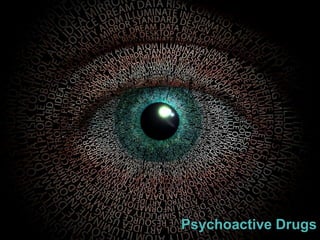
Psychoactive Drugs: Their Effects on the Brain and Personality
- 3. Psychoactive drugs affect the brain and personality by either increasing or decreasing post synaptic transmission. Click the following drugs to see how they affect your brain and personality.
- 4. Ecstasy • increases stimulation in cell • affects Serotonin pathways responsible for mood, sleep, perception, and appetite • indirectly affects the reward pathways of the brain which creates the addictive property of the drug
- 6. • Heroin mimics the natural opiates and binds to opiate receptors blocking the inhibitors from exiting. This results in the lack of inhibiters from the dopamine neurotransmitters causing them to flood out into the synaptic cleft where they bind again and again to the dopamine receptors increasing the stimulation in the cell. • The release of dopamine in the synaptic cleft results in the immediate feeling of sedation and well-being. • The heroin molecules are affecting the area responsible for pain signal, stress response, and emotional attachment. • Heroin can also act as a painkiller.
- 9. Cocaine
- 10. • Before Marijuana enters the system, inhibitory neurotransmitters are active in the synaptic cleft stopping the dopamine molecules from being released. • "Activated by body's own native cannabinoid (called anandamide), cannabinoid receptors turn off the release of inhibitory neurotransmitters. Without inhibition, dopamine can be released." • THC, active chemical in Marijuana, mimics anandamide binding to the cannabinoid receptors. This leads to the inability of the inhibitory neurotransmitters to go out to stop the release of the dopamine molecules in the synaptic cleft. • "Anandamide is known to be involved in removing unnecessary short term memories. It is also responsible for slowing down movement, causing people to become relaxed and calm." • "THC is not able to break down very quickly in the body the way anandamide does. This explains the reason why amnandamide does not produce a perpetual nature 'high'."
- 11. • "the abuse of the drugs leads to some changes in the structure and the function of the brain." • Overtime, the continuous drug abuse makes changes in the brain that "can affect a person's self- control and ability to make sound decisions, and at the same time create an intense impulse to take drugs."
- 12. Social Factors • Although it is difficult to break free once an individual is addicted, it is many times due to societal factors that many start using in the first place • Peer pressure is a common factor that plays a role for many teenagers’ decision to start taking drugs due to their attempt to fit in a particular group of people. • Some use drugs due to a medical condition but later continue to abuse the drug. These medical conditions may include depression or serious injury where drugs are used as painkillers. • Some also start using drugs to escape from their reality and their problems. It can be their short term cure from all their worries but then they continue abusing the drugs to avoid all the problem as long as possible.
- 13. • " Drugs are chemicals that tap into the brain's communication system and disrupt the way nerve cells normally send, receive, and process information. There are at least two ways that drugs are able to do this: by imitating the brain's natural chemical messengers, and/or over stimulating the "reward circuit" of the brain." • Drugs such as "marijuana and heroin, have a similar structure to chemical messengers, called neurotransmitters, which are naturally produced by the brain. Because of this similarity, these drugs are able to 'fool' the brain's receptors and activate nerve cells to send abnormal messages." • Ecstasy, cocaine, and methamphetamine are highly addictive because it directly affects the reward pathway of the brain making the
- 14. The End Bibliography • Drug Abuse and Addiction Causes, Symptoms, and Prevention Facts. (n.d.). WebMD - Better information. Better health.. Retrieved October 7, 2013, from http://www.webmd.com/mental- health/drug-abuse-addiction • Mouse Party. (n.d.). Learn.Geneticsâ„¢. Retrieved October 7, 2013, from http://learn.genetics.utah.edu/content/a ddiction/drugs/mouse.html • Activities, t. e., & will, t. s. (n.d.). The Brain—Lesson 4—Drug Abuse and Addiction (Page 1 of 2). NIH Office of Science Education (OSE). Retrieved October 7, 2013, from http://science.education.nih.gov/supple ments/nih2/addiction/guide/lesson4- 1.htm